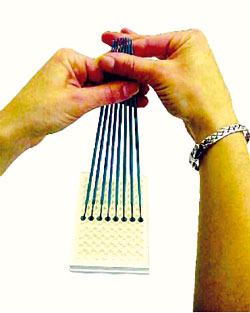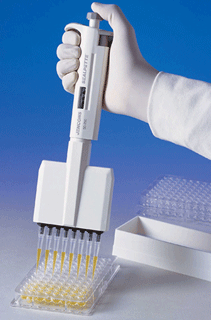Few people outside the field know just how big bioscience can get. The public tends to think of fields like physics and astronomy, with their huge particle accelerators and massive telescopes, as the natural expressions of big science. But for decades, biology has been getting bigger, especially in the pharmaceutical industry. Specialized labs built around the automation equipment that enables modern pharmaceutical research would dazzle even the most jaded CERN physicist, with fleets of robot arms moving labware around in an attempt to find the Next Big Drug.
I’ve written before on big biology and how to get more visibility for the field into STEM programs. But how exactly did biology get big? What enabled biology to grow beyond a rack of test tubes to the point where experiments with millions of test occasions are not only possible but practically required? Was it advances in robots, or better detection methodologies? Perhaps it was a breakthrough in genetic engineering?
Nope. Believe it or not, it was a small block of plastic with some holes drilled in it. This is the story of how the microtiter plate allowed bioscience experiments to be miniaturized to the point where hundreds or thousands of tests can be done at a time.
A Bad Case of the Flu

Most people know about the Spanish Flu pandemic that killed millions around and after the end of WWI. But other outbreaks of influenza have occurred since the 1918 outbreak that, while not rising to the definition of pandemic, were in some ways even deadlier. Once such outbreak was the 1951 epidemic, said to have started on the docks in Liverpool. The weekly death toll from flu in that city would exceed that of the 1918 pandemic, and aside from deaths during The Blitz in WWII, was second only to a cholera outbreak in 1849 in terms of mortality.
The epidemic raged in pockets around the world — the UK, the US, and Canada were particularly hard hit. But Hungary was also suffering from a strong flu outbreak, and getting a handle on the public health problem was difficult. Medical lab supplies were hard to come by in post-war Hungary, and accurate tests of samples from patients were tedious and slow. Something had to be done.
Enter physician-scientist Dr. Gyula Takátsy. Dr. Takátsy saw the basic problem: tests for influenza at the time required relatively large volumes of reagents, large enough to be handled with pipettes, which are glass (or now plastic) tubes that are a little like calibrated drinking straws. With both the reagents needed for the test and the pipettes to dispense them in short supply, Dr. Takátsy realized he needed to miniaturize his assays. He reasoned that smaller volumes could stretch the supply of reagents, and would allow him to do more tests at the same time, increasing throughput.

But what to do about vessels for his miniature experiments, and how to dispense small volumes accurately? The latter question was addressed by using small loops of platinum wires. Wound into spirals, the wires could pick up repeatable volumes of aqueous reagents by capillary action, relying on surface tension to hold the beads of fluid in the spiral cages. Dr. Takátsy also experimented with using ordinary knitting needles to transfer reagents, using the same principle. He dubbed his technique “microtitration,” given that he was serially diluting, or titrating, samples.
As far as vessels for his microtitration technique, Dr. Takátsy couldn’t rely on traditional test tubes — they were just too big, and in short supply anyway. So he hit upon the idea of machining wells into a solid block of Lucite. The wells would be small enough to hold just a few hundred microliters, smaller by far than the smallest test tubes. But the main advantage came from being able to drill the holes in an X-Y array on the plate of Lucite. Spaced accordingly, Dr. Takátsy could transfer reagents using his wires or needles into every well in a row or column at the same time. This allowed him to rapidly assemble assays and, perhaps just as importantly, to handle them all at once easily.
Eight by Twelve

Dr. Takátsy’s original design was a six by twelve array, allowing him to work on 72 reactions at once. While that was certainly a huge advancement in miniaturization, he eventually settled on an even denser arrangement, the now-classic 96-well design. The eight by twelve array is an ingenious design given that both numbers have so many factors; this gives researchers incredible flexibility in setting up experiments. For example, one popular setup is a dilution series across the first 10 columns of the plate, with the last two columns reserved for controls. Duplicates or even triplicates are easily arranged going down the rows of the plate.
While Dr. Takátsy’s design for microtitration was brilliant, it was largely unknown outside Hungary for most of the 1950s. Hungarian refugees began to spread the word of the technique, and soon machine shops in universities around the world were turning out machined versions of the plates. But machining doesn’t scale well, and by the late 50s the first injection molded 96-well plates were commercially available. Later innovations included increasing the density of wells on the plate to 384 and even 1536 wells while maintaining the 2:3 aspect ratio, and different plastic compositions and treatments to support different experimental conditions.

The advent of mass-produced microtiter plates led to developments in supporting instrumentation that Dr. Takátsy could only have dreamed about. As innovative as his wires and needles were, the technique required a fair amount of manual dexterity, and little could be done to vary the amount of fluid transferred. Micropipettors solved this, with finely adjustable pistons used to aspirate fluids into disposable plastic tips. Multi-channel pipettors were later introduced, with the tips spaced so that eight or 12 wells could be handled at once. Automated equipment was introduced to handle microtiter plates, including automated pipettors, peristaltic dispensers, and even acoustic transfer instruments that can repeatable transfer a nanoliter at a time. And an entire industry was built around detection modalities, from simple spectrophotometric devices that read color changes in each well to sophisticated fluorescence readers and even image analysis of an entire plate of stained cells.
The revolution that Dr. Takátsy started with his little machined plastic plate is hard to overstate. By miniaturizing reactions and making multiple experiments in one easy-to-handle vessel possible, Dr. Takátsy’s impact went far beyond the 1951 flu epidemic. He laid the foundation for an industry that successfully harvested the power of going small to do big things.

















And if he’d patented it (looking at that Finger Saving Saw Tech)…. no one would be allowed to produce any, and millions may of died (Not saying the Saw Tech will save millions, but the idea is similar).
What’s to patent? Plate with a lot of wells. The rest came later, and are as, if not more so important.
It is an invention. Good arguments could be made for non-obviousness, and more obvious, simpler things have been patented in the US, EU, and elsewhere for centuries.
For the U.S., ballpark annual numbers are 4000 table saw amputations and 24 000 influenza deaths.
Better table saw technology could prevent almost all of those amputations.
Microtiter plates were a great innovation, but not as direct an influence on the undesirable outcome.
Sort of what happened when the transistor was made smaller.
Nitpick, but the seventh paragraph says former where it should say latter.
haha… he said microtiter
Same thing that ruined high school chemistry! Microchemistry – grumble grumble. No more beakers and flask and test tubes and rings and clamps and burners. Now just little trays and something changes color. They got rid of all the fun chemicals at the same time. Now the kids don’t learn how (not) to break anything or avoid getting boiling goo on themselves or catch themselves on fire, etc. Which I think may have been the primary take-aways from a chemistry class.
The biochem stuff is very cool though. Andromeda Strain.
https://www.google.com/search?q=things+i+won%27t+work+with&ie=utf-8&oe=utf-8
Not in UK, I assure you. We still used glassware (beakers, test tubes, flasks), metal clamps, Bunsen burners and all the good stuff quite recently, at least back in 2010 for GCSE Chemistry. Things may have changed since then, but I don’t really think so.
Although the chemicals are likely less dangerous to work with, and no longer burn a hole through the table if unattended: there was still HCl (but I’ve no idea if at those concentrations it could be considered something dangerous), magnesium ribbons (for fizzy experiments) and probably other stuff which I forgot about and/or which they only take out on more fun days.
Also our Chemistry teacher was really cool and allowed us to make methane soap bubbles, throw them up towards the ceiling and light them on fire (keeping safety rules etc.) a couple of times. Great stuff. Will not reveal more as a precaution against getting them in trouble.
“While Dr. Takátsy’s design for microtitration was brilliant, it was largely unknown outside Hungary for most of the 1950s. Hungarian refugees began to spread the word of the technique, and soon machine shops in universities around the world were turning out machined versions of the plates.”
It was intended to be an export-success produced by the LaborMIM in Esztergom, Hungary (Labor MűszerIpari Művek) in the ’60s, and was exported by Metrimpex, the sole company behind the iron curtain with the option to do so.
Takátsy originally asked for a patent on 23rd March 1950, but the Office replied on !14th June 1951! that it is not considered to be patentable, because of not being a considerable improvement. He did not stop his paper-war until he finally succeeded in patenting it on 7th May 1963. Tough patent lacking state sponsored export of the product began, which resulted in the design copied without reprisals.
All the gory details in Hungarian: http://www.mtakszi.iif.hu/kszi_aktak/doc/BrT_34.pdf